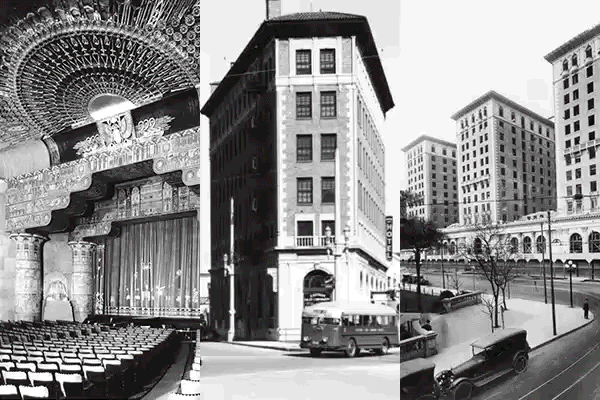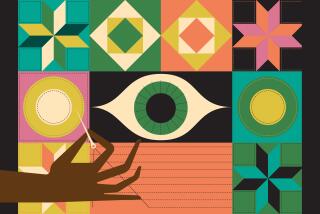An Object of Wonder, Down to Its Fibers
- Share via
Leaning over the railing of a third-floor balcony of the Ahmanson Wing of the L.A. County Museum of Art, Dale Gluckman gestures at the floor of the atrium below and says, “This is the way the Ardabil carpet was meant to be seen, looking down from above.”
The rare carpet, which measures 23 feet by 13 feet, has proved a challenge to exhibit, says Gluckman, who is the museum’s costume and textiles curator. Considered a treasure of the museum’s permanent collection, the 16th century carpet has been rolled up and in storage for 15 years due to the fragility of its silk and woolen fibers. Beginning today, however, it will be displayed on a platform on the ground floor of the Ahmanson atrium, through Aug. 9. Afterward, it will be sent to Surrey, England, where it will be restored to its former glory at the Historical Royal Palace Textile Conservation Studios at Hampton Court Palace. The cost of such a project? Around $250,000. The value of the Ardabil carpet? Priceless.
Exhibition and restoration of the carpet is the pet project of LACMA director Graham Beal. “It struck me as ironic, to say the least, when people would ask me about the greatest work of art in the collection, I would explain that one of those would be the Ardabil carpet. Yet, no one has seen it for 15 years, because it is not in [long-term] exhibition condition. And the process of converting it to exhibition condition is a very expensive one.”
He adds, “It’s a big chunk of money to throw at one work of art, so it required a certain executive resolve. Yet this carpet is like a Cezanne or Van Gogh; it is right up there.”
Even after the restoration, for which the museum is raising funds, the carpet won’t be on view again for at least a year, Beal says. “This is a chance to see one of the objects that in theory you would put under your arm and run out with if the building was on fire.”
After its return to LACMA, Linda Komaroff, the museum’s associate curator of Islamic art, said she hopes to exhibit the carpet regularly in the galleries for Islamic art, which are to be expanded. She would like to mount it on the floor so that it can be seen from above. To prevent it from receiving too much light, it will alternate in the galleries with the museum’s 16th century Coronation carpet, a figural Persian carpet used at the Westminster Abbey coronation of King Edward VII in 1902.
According to Gluckman, the Ardabil carpet is the standard by which Persian carpets can be measured. “This is one of the most famous carpets in the world because of its technical quality and its extraordinary aesthetic qualities,” she says. “The carpet has wonderful scrolling vines, with some of the edges outlined in red against a deep blue ground, so the pattern seems to float. The center medallion is similar to an Islamic book cover, but it has the unusual addition of the mosque lanterns at either end.”
In scale, complexity and color, it is unique, except for its mate in the collection of London’s Victoria and Albert Museum. In fact, for reasons that remain unknown, about 100 years ago, some scoundrel removed the border of what is now LACMA’s carpet and added it to a carpet now at the Victoria and Albert, known as the London Ardabil.
Both carpets are thought to come from the town of Ardabil in northwest Iran and bear identical Persian inscriptions by the 14th century poet Hafiz: “I have no refuge in this world other than thy threshold / My head has no resting place other than this doorway.” Both are signed and dated “Work of a servant of the court, Maqsud of Kashan, 946.” Gluckman points out, “The fact that it’s dated is very unusual, for any textile. We know it’s from 1539-1540. But we do not know if the name is that of the designer or the patron who commissioned it.” It is unlikely that the signature has much to do with the weaving since it took four people, probably women and working simultaneously, two to three years to tie the carpet’s 15.5 million tiny knots.
“It’s a tremendous mystery because it’s rare to have a signed and dated carpet, but beyond that, it’s hard to say,” says Komaroff. “There are a number of medallion carpets but not with lamps or not signed and dated. It was certainly a royal commission, something that could only have been afforded by the ruling elite. In Iran today, they are weaving a copy of it for the shrine at Ardabil. I think the Iranian community in L.A. will be excited to see this carpet.”
The Safavids, who ruled Iran from 1501 to 1732, had dynastic ties to the shrine at Ardabil. The carpets were made during the reign of Shah Tahmasq I, a renowned patron of the arts who was to be buried at the shrine. Under the Safavid rulers, carpet weaving evolved from a rural and nomadic craft to an art form, and royal factories for carpet weaving were established in the cities of Kashan, Tabriz, Kirman and Isfahan. Gluckman explains, “What we think of as Persian art is usually from the Safavid period, which was a great artistic flowering.”
Although the curators emphasize the uncertainty around the history of the carpets, their best conjecture is that the carpets were placed side by side in the Jannat-saray, the largest structure in the shrine complex at Ardabil, for special occasions such as visits by the shah or religious observances. The collapse of the building’s dome, due to an earthquake in the middle of the 19th century, may have led to their sale to pay for the shrine’s restoration.
*
The Ardabil and Coronation carpets were given to the museum by J. Paul Getty, before he had a museum of his own. Getty, who kept the Ardabil in his New York apartment, had acquired it from art dealer Joseph Duveen, who said he considered it one of his all-time treasures. Duveen had been unwilling to part with the carpet until 1938, when he needed cash. He had acquired it from the daughter of a wealthy Dutch immigrant living in New York, Joseph R. De Lamar, who had bought it from the historic auction of carpets belonging to the late American multimillionaire Charles Tyson Yerkes. Yerkes bought the Ardabil from Vincent Robinson, who got both carpets from an agent for the trading firm of Ziegler & Co. of Manchester and Sultanabad, which is believed to have bought them from the shrine at Ardabil.
In 1949, Getty donated the Coronation carpet to LACMA; in 1953, he gave the museum the Ardabil carpet, though he remarked that he did so “not without pain.” In 1974, the Getty Museum borrowed the Ardabil carpet for 10 years, exhibiting it with its 18th century furniture in the Malibu museum. Since its return to LACMA, it has remained in storage because of the excessive acidity in its fragile fibers and wear and tear from its various owners.
Gluckman compares the situation to the Francois Boucher tapestries that were sent to Hampton Court for restoration last year. “LACMA’s conservation center is outstanding for paintings, paper, objects and textiles, but something the size of the Ardabil carpet or the Boucher tapestries requires special equipment.” Hampton Court does all the conservation work for Kensington Palace, Buckingham Palace and Hampton Court. She adds hopefully, “We are actively seeking funding to pay for the restoration of the Ardabil carpet. People who understand the importance of conservation are often very generous.”
*
THE ARDABIL CARPET, L.A. County Museum of Art, 5905 Wilshire Blvd. Dates: Opens today. Hours: Mondays, Tuesdays and Thursdays, noon-8 p.m.; Fridays, noon-9 p.m.; Saturdays and Sundays, 11 a.m.-8 p.m. Ends Aug. 9. Prices: Adults, $7; students and seniors, $5; children, $1; under 5, free. Phone: (323) 857-6000.
More to Read
The biggest entertainment stories
Get our big stories about Hollywood, film, television, music, arts, culture and more right in your inbox as soon as they publish.
You may occasionally receive promotional content from the Los Angeles Times.










